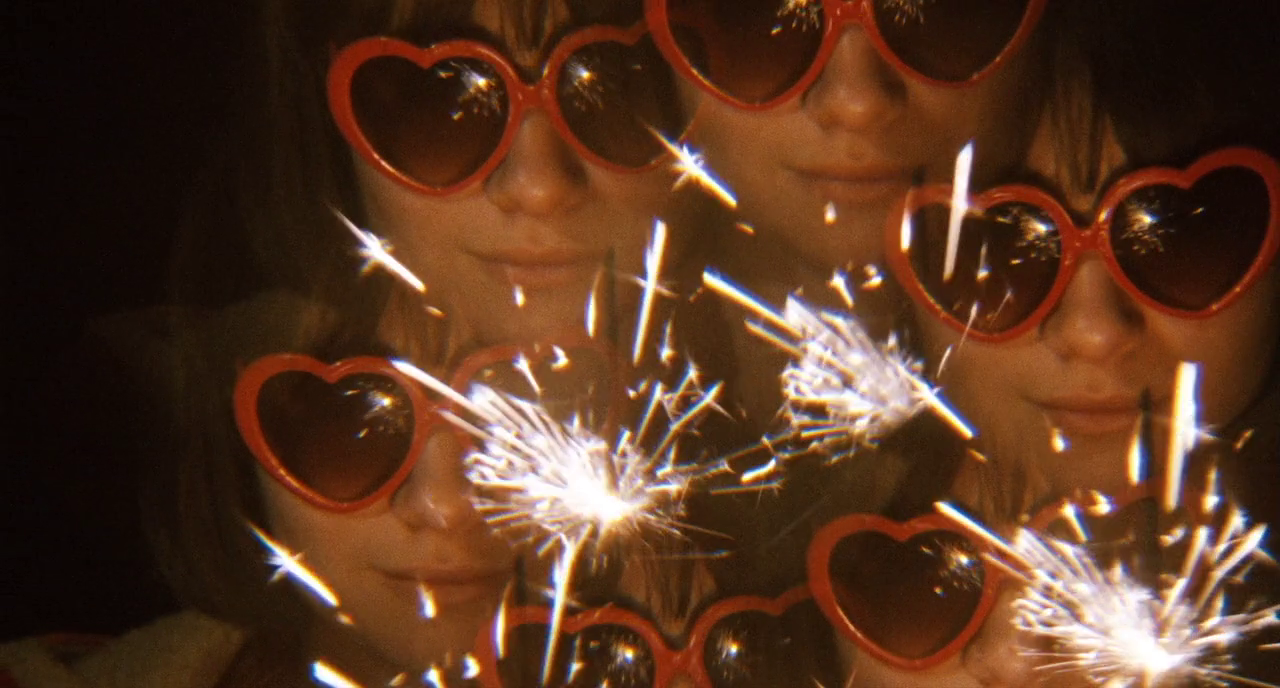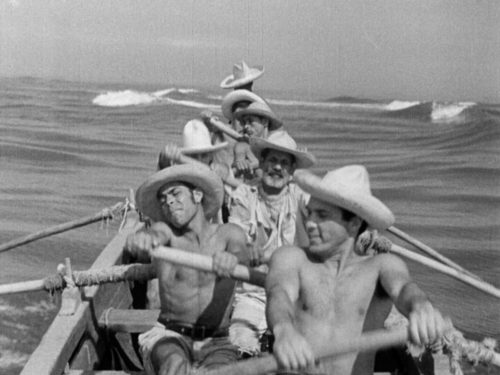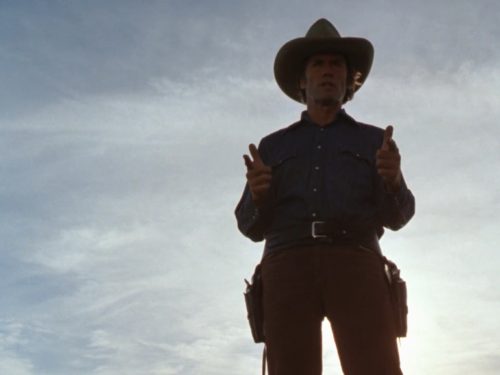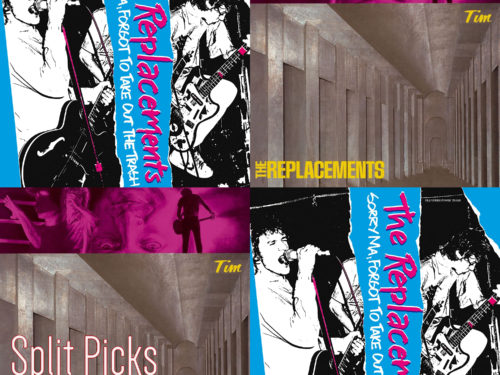Ayoade hasn’t directed a feature since 2013. Oliver O’Sullivan looks back on his pair of films, two nuanced character studies that are deeply in conversation with each other
“I am a prism. I am lucid. I am exciting and delicious.” — Graham Purvis, Submarine
Garth Marenghi’s Darkplace (2004) is the skeleton key. The Channel 4 cult classic set the template for creator/director/star Richard Ayoade’s art. For a show that seems like a low-stakes sendup, its stylistic roots and thematic layers run deep. The premise alone is dense: washed-up horror author Garth Marenghi digs into his archives to unearth a vanity project from the ’80s, a failed TV show that networks didn’t pick up, about doctors packing heat at a low-rent hospital located above the gates of hell. The bulk of the program is a straight-ahead replay of the shelved episodes, padded with present-day talking head commentary from the principal “actors” — Garth Marenghi (co-creator Matthew Holness), Dean Learner (Ayoade), and Todd Rivers (Matt Berry). Mimicking and spoofing everything from hacky horror TV shows, Stephen King adaptations, and the Lars von Trier series Kingdom, Garth Marenghi’s Darkplace is perfectly terrible looking. It takes skill to make something so shoddy, self-aggrandizing, and incompetent on purpose. The show within the show was meant as a monument to Garth’s multi-hyphenate genius (as an “author, dream weaver, visionary, plus actor”), but instead it exposes the limited intellect of its fictional creator and his persistent industry failure.
Garth is a blowhard buffoon who has constructed a fantasy world around himself to bury his real dark place — his deeply repressed repository of insecurities and inadequacy issues. But Ayoade’s character on Darkplace, Garth’s producer/publisher/enabler Dean Learner, aka Thornton Reed on the show within the show, is as prime an example of delusion as his meal ticket. Under the harsh gaze of the cameras, the smooth patois Learner affects “off-camera” crumbles spectacularly. As an actor, he goes stiff and delivers all of his lines in a stilted, unnatural, uncomfortable, adenoidal rapid-fire. The cigar-chomping producer façade completely disappears. This is just the earliest example of how Ayoade peels apart the male psyche. This gulf between ego and reality, of multiple personas overlaid, would later fuel Ayoade’s signature brand of comedy and world-building in his two feature films, Submarine (2010) and The Double (2013). Darkplace’s Marenghi and Learner are manly in the ’80s mold — pig-headed, misogynistic, entitled, and needy. The protagonists of his film are self-aware introverts, wallflowers, dreamers, and romantics. The fragility in Ayoade’s performance of Learner opened up a lane for Submarine’s Oliver Tate and The Double’s Simon James, who are polar opposites of Marenghi, but with that same underlying disquiet.

Ayoade’s modest collected works as a director start with Darkplace, pivot with a handful of music videos for key aughts-era indie bands (Arctic Monkeys, Yeah Yeah Yeahs, Vampire Weekend, Kasabian), and culminate in these two lovely, unassuming feature films. After punching the clock, and picking up a BAFTA for acting on the great sitcom The IT Crowd, Ayoade filmed Submarine, an adaptation of Joe Dunthorne’s novel, and The Double, based on the novella by Fyodor Dostoyevsky, in a burst of creativity. He seemed to be leveling up and developing an authorial voice. He’s since settled back into a comfortable groove — acting in indie films (like Joanna Hogg’s The Souvenir (2019) and this year’s The Souvenir: Part II), doing a fair amount of voice work (Boxtrolls [2014], Neo Yokio, The Mandalorian), holding down a day job as a TV-host-cum-talk-show personality (The Crystal Maze, Question Team, Travel Man, frequent appearances on The Graham Norton Show), and writing satirical memoirs (in which he reenacts some of the persona splitting and footnoting that dots his filmography) — but sadly he doesn’t have any more directorial projects in the offing.
Both his features are visually inventive and deeply referential. Both drew easy comparisons to Wes Anderson’s diorama aesthetic and Terry Gilliam’s maladroit dystopias, respectively, which Ayoade famously resisted. Both are more complex than such superficial reference points would suggest, with themes, idiosyncrasies, and fixations all Ayoade’s own: fractured identities, the psychology of delusion, reality testing, fragile masculinity, mediation as a defense mechanism. Both films stand apart from the tide of mainstream comedy at the time and have myriad connections to his earlier TV work. Both of his films are brimming with stylistic playfulness, bridging ribald mid-century Ealing comedies, the stone-faced lunacy of Monty Python, and the pop-culture addled mania of 21st Century Channel 4 BBC sitcoms. At the same time, they are absorbing, self-contained character studies in beautifully realized, neo-expressionist worlds. They are in conversation with each other but they each have a distinct look and feel and rhythm. Looking back, they both already feel like fading gems.

Submarine takes place over unequal chapters. It follows 15-year-old Wales-born Oliver Tate (Craig Roberts) as he courts his eczema-afflicted crush, Jordana Bevan (Yasmin Paige), loses his virginity, pulls away from the emotional demands of his relationship, and comes to terms with his regret. Amid all this, he intervenes in the low-key drama of his parents’ marriage; both are depressed, withdrawn, and seemingly passionless. Oliver’s mother, Jill (Sally Hawkins), is drawn into the self-help practices of their neighbor Graham Purvis (Paddy Considine), a former flame who has insinuated himself back into her life. Oliver takes it upon himself to rekindle his parents’ romance and dispatch with the interloper. Oliver fumbles through episodic coming-of-age rituals — first love; the herd mentality of secondary school; coming to terms with his Welsh home; seeing his parents as flawed people — en route to a more fully formed concept of manhood.
In Submarine, Ayoade’s avowed love for Eric Rohmer is internalized, and Truffaut’s Antoine Doinel cycle looms large. The chapters, deadpan voiceover, custom Futura font, epistolary sequences, Oliver’s pea coat and briefcase, and the mixed-media digressions drew the Wes Anderson comparisons, but, in its post-twee shagginess, there are shades of Alex Ross Perry, Whit Stillman, Hal Ashby, the primary-color romance of Punch-Drunk Love (2002), Benjamin Braddock, and, prominently (including a sketch over Oliver’s bed), ’70s Woody Allen. The references are endless but the alchemy is smooth, which is part of what makes it one of the rare modern coming-of-age films that’s worth a damn.Submarine and The Double both take place in isolated, enclosed settings. Submarine’s circa-1986 Wales is idyllic, surrounded by sea and soft, lilac-colored skies. Conversely, The Double’s chiaroscuro near-future dystopia is an impersonal, claustrophobic world full of fog, whirring machinery, and anonymous apartment complexes. Simon James (Jesse Eisenberg) is a competent but overlooked low-level drone at a company with no discernible purpose. One day a new employee is hired, James Simon (also Eisenberg), who looks identical to Simon, but with a disposition markedly different and clearly more amenable for navigating the oppressive surroundings. The two form a mutually beneficial, uneasy alliance. But matters intensify when Simon’s love interest, Hannah (Mia Wasikowska), becomes infatuated with James. Simon’s jealousy leads to questionable actions and James’ supercilious nature escalates until it becomes clear only one of them can survive. With the twinning of Simon and James, this theme of competing conceptions of masculinity, of its poles, drives the narrative. “I can see the man that I want to be versus the man that I actually am,” Simon says in a rare unguarded moment on the train midway through the movie.
Like Submarine, The Double courts comparisons to French New Wave staples, this time Alphaville (1965) and Le Samourai (1967), but also the noir expressionism of Hitchcock’s The Wrong Man (1956) and Orson Welles’ The Trial (1962), as well as the surreal artificiality of modern masters like Aki Kaurismäki and Roy Andersson. It also feels like a cousin to Spike Jonze’s Adaptation, another film that pits dueling halves of an actor’s persona against each other. Ayoade cites Cronenberg’s Dead Ringers and Scorsese’s After Hours (1985) — the nocturnal setting and Simon’s slightly oversized gray linen Stop Making Sense suit are direct nods. And Garth Marenghi haunts both films in the form of Paddy Considine, a mulletted peddler of a self-help “color” philosophy in one and the star of a cheesy sci-fi TV show in the other.
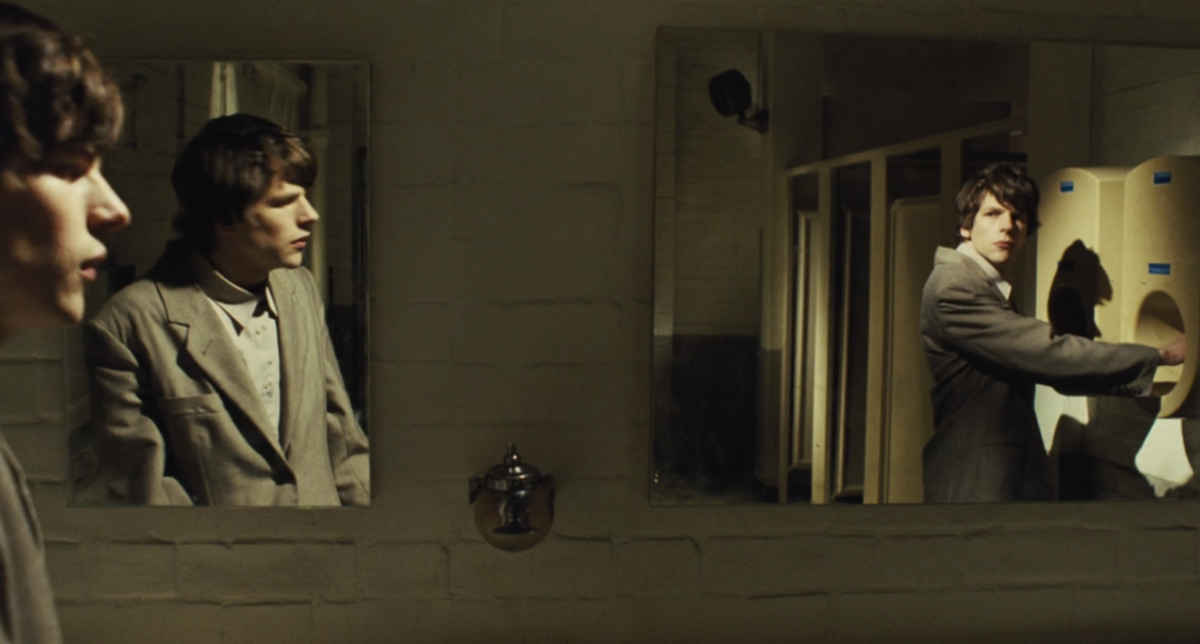
Both of Ayoade’s films deal with divisions of identity, fragmented selves. It’s no wonder he dipped into the werewolf myth multiple times for his music videos — Vampire Weekend’s “Cape Cod Kwassa Kwassa” and Yeah Yeah Yeahs’ “Heads Will Roll” — and that he was tapped to helm an Abed-centric episode of Community — the fabled Pulp Fiction/My Dinner with Andre mashup “Critical Film Studies.” In Submarine, those striking symmetrical medium shots that were emphasized in the marketing for the movie are complemented by deft framing devices that refract, mirror, distort, or obscure. Oliver dons different personas in search of either something authentic or, in the meantime, something that will stick. He talks about trying out affectations — reading the dictionary, flipping coins, smoking a pipe, listening to French crooners — to see what kind of person he wants to be. Other plot points hinge on him pretending to be other people to manipulate the events around him. He will, for instance, write a letter to his mother from his father — “Let me re-discover your sweet spot. Best wishes from your husband, Lloyd (Happy New Year in advance)” — to rekindle some affection in their floundering relationship. The Double, on the other hand, makes this idea of a fragmented self literal. Simon faces down his doppelgänger for the majority of the film, first admiring his confidence and the ease with which he drifts through the dystopian environs, then resenting his aggression and manipulation. Add to that, Simon’s boss (Wallace Shawn) repeatedly calls him “Stanley,” and the story is replete with various other misspellings, misnomers, and identity erasures of Simon within the system. Oliver’s efforts to fix his parents’ marriage and the fractured doppelgänger motif in The Double are practically crying out for psychoanalysis.

Both films are essentially melancholic romantic comedies. If you’re coming in with prior knowledge of Ayoade’s TV work, it’s a bit jarring how much drama he brings. The jealousy and possessiveness of his protagonists, their penchant for cruelty and selfishness, are often startling rather than comical. Both are painfully self-aware and sensitive types, but neither is above a bit of emotional gamesmanship. The scheming that both Oliver and Simon employ are key plot points, with remnants from the high-concepts of Ayoade’s sitcom days. In a key early scene in Submarine, a moment that Oliver identifies as “one of those vivid memories of youth that I would cherish when I was old and frail,” he engages in tormenting an outcast classmate with Jordana, stealing her bag and tossing it around in the woods. This leads to her falling into a bog and, soon after, leaving school and disappearing from the narrative. The guilt is present but tamped down. As Oliver states, “Essentially, I disapprove of bullying. Jordana, however, seems to enjoy it in moderation. I must not let my principles stand in the way of progress. I must be willing to adapt.” It works out for him, so the end justifies the means, but at a cost.
Similarly, Simon is not an altogether sympathetic figure. He spends his evenings in his dank apartment spying on Hannah across the way, peering through his long Rear Window-esque telephoto lens into her apartment as she engages in her own escapist activities. She frequently creates small paintings that she destroys and throws down the trash chute, which Simon sneaks down and picks out of the duct with a coat hanger. He gets caught several times doing this — by janitor J Mascis and eventually by Hannah herself — and the violation of this act, the shades of stalking he exhibits, are undeniable. At the same time, there’s some poignancy to his ritual of collecting, reassembling, and cherishing these paintings, the first of which is, fittingly, a take on Magritte’s La reproduction interdite. In The Double, Simon is able to take advantage of his doppelgänger and vice versa, the two switching places in several scenarios. Simon gets help getting closer to Hannah and James is able to avoid work and evaluations by having Simon do it instead. There’s also, of course, the date scene, where Hannah thinks she’s out with James but Simon takes his place and James is in the bathroom feeding him lines — a classic sitcom setup.
In Submarine, Ayoade and his cinematographer Erik Wilson — who also shot Paddy Considine’s nasty companion piece Tyrannosaur (2011) — use a wide variety of techniques inspired by Henri Decaë (The 400 Blows [1959], A Very Private Affair [1962], Le Samourai ]1967]) and Nestor Almendros (The Man Who Loved Women [1977], Pauline At The Beach [1983], Days Of Heaven [1978]). They employ minimal lighting, still shots contrasted with handhelds, 8mm reels, dream and fantasy sequences, frequent freeze frames, and more. The Double, on the other hand, also with Wilson on as director of photography, is a puzzle of staging with a much different texture and visual tone. In fact, it’s easy to underrate The Double as a bold departure. Ayaode and Wilson use frequent tracking shots and pans, as well as close-ups and split-diopters. The complex blocking of scenes turns on the trick of placing two Eisenbergs in the same environment and frame. The warmth and magic-hour seaside beauty of Submarine are contrasted/complemented by the cold, gray, clanking vacuum of The Double. Both have a wistful, downcast romanticism about them, but Oliver’s navel gazing in Submarine is nurtured by the setting, whereas, for Simon, this same impulse is just an ember in a harsh, retro-futurist concrete prison.
Ayoade’s wallflower characters spend an inordinate amount of time at a distance, watching and observing, fading into the surroundings, cataloging. Both his protagonists are introverts who need to find self-assurance in hostile environments. Their nature is to observe from afar, to pine and consider, to overanalyze and overthink. They are also not good at being covert. Oliver peers around a tree at Jordana and is eyed, he observes his mother from the stairs and she closes the door on him, he breaks into Graham Purvis’ house and gets caught. You can’t discount Oliver’s fleeting, fourth-wall-breaking glances at the camera either, a more reserved, lyrical version of what, say, Zack Morris would do in his adolescent misadventures. “Sometimes I wish there was a film crew following my every move,” he says at one point.
In The Double, Hannah is painfully aware of her place as an object of desire; Simon is not the first person to exhibit stalking behavior: “whatever, men look at women; you get used to it,” she says, before exploding with, “Do you think just staring at me is some kind of meaningful gesture?” The portfolio that Simon compiles of her paintings represents a portrait of her from a limited and warped vantage. It’s also a symbol for the film itself, a collection of recreated masterworks torn up, tossed down a chute, and reassembled with care. So too with Oliver’s collages, indexes, scribbles, and typewritten notes. Both Submarine and The Double brandish their influences and weave these elements through their narratives and characters. Submarine’s romanticism and bookishness is informed by both Oliver’s and Ayoade’s personalities. Oliver’s idea to give Jordana paperback copies of The Catch in the Rye, King Lear, and Nietzsche at a screening of La Passion de Jeanne d’Arc, so they can develop common interests, squares with Ayoade’s own admiring, heart-on-sleeve direction. The Double is the photo negative, it’s oppressive setting amplifying Simon’s and Ayoade’s particular concoction of anxieties and preoccupations.
Both Submarine and The Double end with wish-fulfillment sequences, circling back on visions from earlier in the film. In Submarine, as Oliver sits on the beach, reflecting on his mistakes, Jordana magically appears in her red coat, just as his Don’t Look Now-referencing dream prophesied, and he is granted the chance to apologize for his transgression and find a new spark. In The Double, Simon recreates the suicide he witnessed at the beginning of the film, waving to James, who’s shackled in his apartment, and leaping to break the psychic bond between them. As the ambulance takes him away, horribly maimed and in a delirious state, he hallucinates Hannah and the Colonel — the symbolic paternal figure of the State — riding with him, and gets the glimmer of recognition he longed for. In close up, as lights swirl outside the vehicle, he simply says, “I’d like to think I’m pretty unique.” Then the soundtrack gives way to the uncanny exotica of Kim Jung Mi’s “The Sun.”
“Most people think of themselves as individuals, that there’s no one else on the planet like them,” says Oliver in the very first line of Submarine, predicting his successor Simon’s neurosis. “This thought motivates them to get out of bed, eat food, and walk around like nothing’s wrong.” Sitting at the window of his bedroom, staring out at the sea, Tate has happened upon a colloquial definition of ego, the all-important core of a person’s self-worth, and he pegs it as a shaky mechanism. As he sits there, lost in thought, the camera sweeps across the wall around his bed, which is covered in a collage of photographs and inspirational reference points, a sense of self constructed through a pop-culture lens. He glances sidelong into the camera and the film slips into the first of many lovely, nostalgic etudes from Alex Turner. In Submarine’s opening line and The Double’s closing line, Richard Ayoade’s two films close the loop, clearly articulate their psychology, and bookend each other beautifully.
Follow our series of The Best of the 2010s in Film here

Purchase or stream Submarine
Purchase or stream The Double
Stay up to date with all things Split Tooth Media
(Split Tooth may earn a commission from purchases made through affiliate links on our site.)

